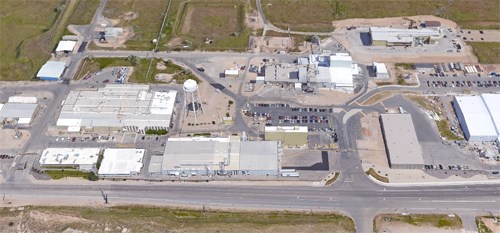The vexing economics of carbon fiber manufacturing
Hexcel's VP and GM Americas, Mike Canario, reviews tough economics the govern carbon fiber manufacturing today, and how they might affect future supply.

This carbon fiber manufacturing facility in Salt Lake City, UT, US, is one of several operated by Hexcel. Hexcel's VP and GM Americas, Mike Canario, talked at CW's Carbon Fiber 2014 conference last week and noted the numerous economic challenges associated with carbon fiber manufacturing expansion.
Mike Canario, VP and GM Americas at carbon fiber manufacturer Hexcel (Stamford, CT, US), spoke at ÂÌñÏ×ÆÞ's Carbon Fiber 2014 conference in La Jolla, CA, US, last week, addressing opportunities and challenges associated with being a supplier of carbon fiber to the composites industry.
Canario provided a rare and frank glimpse of the economics of carbon fiber production and offered revealing insights about how Hexcel sees the market and calculates when and how to expand capacity to meet market demand for carbon fiber.
Carnario noted first that since the mid-1980s, carbon fiber demand in the aerospace industry has been fueled by a variety of important but relatively low-volume military programs, including the B-2, V-22, F-22 and F-35. On the commercial aircraft side, carbon fiber has seen limited use on a variety of Boeing and Airbus planes for many years, but it wasn't until the Boeing 787 and the Airbus A350 XWB were developed that carbon fiber firmly established its place in the aerospace industry. Each plane features carbon fiber in every major structural component (wings to fuselage to tail) and together, at full-rate production, said Canario, will consume more carbon fiber in one year than the F-35 program will over its entire life.
Looking ahead, through 2018, Canario said carbon fiber is expected to growth healthily in ever major market:
- Sports and leisure: 5.7% CAGR (compound annual growth rate)
- Aerospace: 10% CAGR
- Industrial: 14.4% CAGR
- Overall: 12.3% CAGR
What does this mean? Canario said the industry should expect 40,000 metric tons of additional carbon fiber demand in the next five years.
Good, right? Well, yes and no. In short, said Canario, carbon fiber ramp-up is not cheap. Carbon fiber manufacturing requires a polyacrylonitrile (PAN) precursor, the expense of which is exacerbated by the fact that it takes 2 kg of PAN to produce 1 kg of carbon fiber. Further, the high-temperature ovens used to convert PAN to carbon fiber are energy- and capital-intensive. Finally, construction and commissioning of a new carbon fiber plant can take 12 to 18 months, which prolongs return on capital expansion investment.
The real question, Canario said, is this: "Can the current carbon fiber economic model work?" For emphasis, he noted the following costs to manufacture the two basic types of carbon fiber:
- Aerospace grade: $85,000 to $220,000 per metric ton
- Industrial grade: $25,000 to $95,000 per metric ton
Given the current economic model, Canario noted, a carbon fiber manufacturer will expand capacity only if a sustainable rate of return can be guaranteed. This means minimizing risk and capital costs and emphasizing long-term contracts — like that which Toray has with Boeing for the 787 and Hexcel has for the A350 XWB.
For the future, Canario listed several factors that he expects will influence the type and quantity of carbon fiber on the market:
- Alternatives to PAN being developed might prove viable, but will trade performance for cost
- Capital costs will become increasingly important and challenging and will drive much capacity expansion decision-making
- Full use of carbon fiber assets will be the only way to perpetuate the current economic model
- Qualification of carbon fibers for aerospace is time-intensive and represents asset underuse.
"Under-utilized assets are the scariest thing for carbon fiber makers," Canario said.
Related Content
McLaren develops aerospace-inspired ART method for volume composite super car engineering
Automated rapid tape (ART) technique, already deployed at the MCTC and to be used for future McLaren models, is capable of producing lighter, stiffer and stronger carbon fiber structures with less waste.
Read MoreHonda begins production of 2025 CR-V e:FCEV with Type 4 hydrogen tanks in U.S.
Model includes new technologies produced at Performance Manufacturing Center (PMC) in Marysville, Ohio, which is part of Honda hydrogen business strategy that includes Class 8 trucks.
Read MoreBladder-assisted compression molding derivative produces complex, autoclave-quality automotive parts
HP Composites’ AirPower technology enables high-rate CFRP roof production with 50% energy savings for the Maserati MC20.
Read MoreASCEND program completion: Transforming the U.K.'s high-rate composites manufacturing capability
GKN Aerospace, McLaren Automotive and U.K. partners chart the final chapter of the 4-year, £39.6 million ASCEND program, which accomplished significant progress in high-rate production, Industry 4.0 and sustainable composites manufacturing.
Read MoreRead Next
Next-gen fan blades: Hybrid twin RTM, printed sensors, laser shock disassembly
MORPHO project demonstrates blade with 20% faster RTM cure cycle, uses AI-based monitoring for improved maintenance/life cycle management and proves laser shock disassembly for recycling.
Read MoreCutting 100 pounds, certification time for the X-59 nose cone
Swift Engineering used HyperX software to remove 100 pounds from 38-foot graphite/epoxy cored nose cone for X-59 supersonic aircraft.
Read MoreCeramic matrix composites: Faster, cheaper, higher temperature
New players proliferate, increasing CMC materials and manufacturing capacity, novel processes and automation to meet demand for higher part volumes and performance.
Read More












